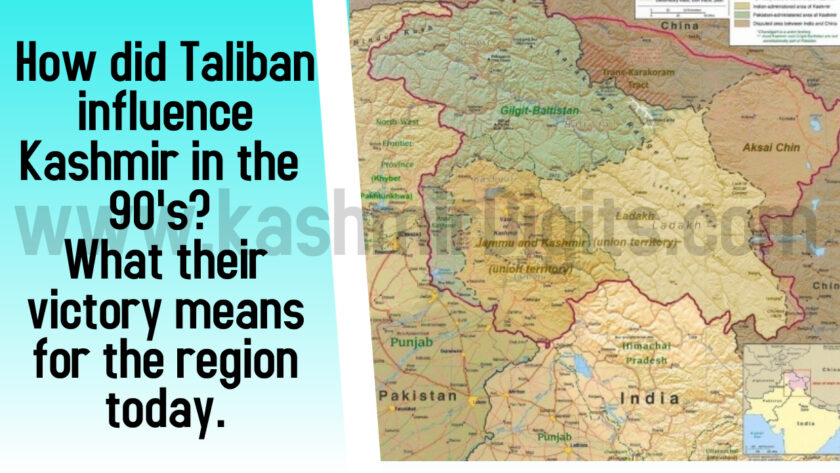With Taliban taking over Afghanistan and establishing governance the status quo in and around the Indian subcontinent has changed.
Kashmir a bone of contention for so long between India and Pakistan will be under the scanner after the resurgence of Taliban. Already former J&K DGP SP Vaid has said that Taliban’s victory will ’embolden terrorists in J&K’.
While India is still weighing up its next move in response to developments in Afghanistan, Pakistan has somewhat already endorsed the new regime. Imran Khan saying that the Afghans have “broken the shackles of slavery”.
However, when it comes to Kashmir, the immediate threat isn’t the dispersion of the militant group towards the region but the ideological and tactical assistance they offer.
Let’s take a look at how the group influenced Kashmir uprising in the late 1980s. Also what Taliban’s win means in today’s context.
The Fall Out from Soviet War.
As the Kashmir conflict began in 1980s with the rebels taking up arms, it drew inspiration from the events of the world at that time. Success of Islamic revolution, Palestnian intifada and victory of Afghans against all powerful Soviet Union were all big factors.
The Afghan victory in particular romanticized the concept of self-determination and an armed struggle. This led to renewed calls for secession from India in the valley. But this time the calls were accompanied by sounds of Kalashnikovs echoing in the region.
Hizbul fighters, believed to be backed by Pakistan began arriving Kashmir in 1992/93. Some of these were believed to have combat experience during the Soviet war. They were thus were trained in tactics of Afghan fighters. Their strength lied in engaging the Indian forces in a stalemate.
With time the tactics changed once again drawing from fighters in Afghanistan this time with the rise of Fidayeens in 1998-99. This new group of militants would undertake suicidal missions causing heavy damage to government or military establishments. The Fidayeen were the Afghan tribals in their war against the Soviet.
Influence of Taliban
Taliban’s ideology greatly influenced Kashmir’s armed insurgence. During the Soviet War, they had used guerilla warfare, hit and run, and other such ambush techniques to hurt their invaders. This was done in accordance with the arsenal available and using the rocky terrain to their advantage.
The militants in Kashmir adopted similar tactics while training and fighting alongside the Afghani Mujahideens and Taliban. The focus was on guerilla tactics, ambush, and targeting army strong points.
This also meant when Taliban established its Islamic Emirate in late 90’s they had shown how unity powered by guns and the will to fight till death would result in victory eventually.
This further fanned the flames of a growing ideological change in Kashmir. They were drifting away from traditional methods of achieving a solution through talks and diplomacy.
Now that Taliban are in power again through their same tactics, what influence it could have on Kashmir?
What Taliban’s rise means for India and Kashmir.
There will be a fallout from this war as there was almost 30 years ago. Pravin Sawhney, a renowned defense expert, and a former Indian army officer has affirmed this. He told a foreign media house that, should the Taliban return to power in Afghanistan it would certainly have an impact on Kashmir.
“In my assessment, there will be a consolidated front comprising China, Pakistan and the Taliban. And Kashmir will not remain unaffected,” Sawhney said.
Also, Taliban’s victory will lead to the revealing of their tactics. Their use of improvised explosive devices (IEDs), guerilla tactics, and sticky bombs will be something that is a cause for concern for Indian authorities.
Already 4 sticky bombs were recovered on August 13 in Mendhar area of border district Poonch. This may suggest that the spillover of ideas may already be happening.
Then there is also the danger of Taliban militants moving to other parts of subcontinent once they have firmly established their status in Afghanistan. A similar situation was experienced in the 1980s after the Soviet Union was forced to leave.
Akanksha Narain, an analyst with a political and risk consultancy firm in New Delhi, said, “Mujahideen fighters until 1989 fought against the Soviet troops, then dispersed to other theaters, from Chechnya and Kashmir to the Middle East.”
“A similar situation will arise where many fighters, particularly foreign fighters, might pivot to new theaters or return to previously active theaters. This poses a threat for India and Kashmir,” she added.
Is India prepared?
The conflict in Kashmir has seen a lot of changes over the years. This Taliban reemergence will have an impact on the situation. Times are different than the 1980s when India first faced such armed struggle within its parts.
Since then India has been dealing with insurgency in the region for 30 years. They are better prepared and have built a robust security grid and intelligence network.
Whatever the coming days hold and no matter how well equipped anyone is, this incarnation of Taliban poses a challenge to the world and India’s policy on Kashmir.
They cannot simply turn a blind eye to the events of Kabul and must prepare to deal with them one way or another.
